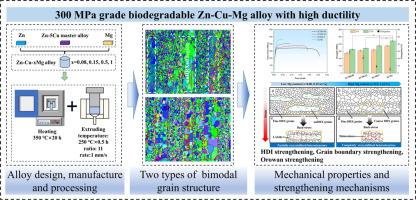300 MPa grade high-strength ductile biodegradable Zn-2Cu-xMg (x = 0.08, 0.15, 0.5, 1) alloys: The role of Mg in bimodal grain formation
IF 11.2
1区 材料科学
Q1 MATERIALS SCIENCE, MULTIDISCIPLINARY
引用次数: 0
Abstract
300 MPa grade biodegradable Zn-2Cu-xMg (0.08, 0.15, 0.5, and 1 wt.%) alloys with different bimodal grain structures were obtained by casting and hot extrusion. The effects of the Mg element on the microstructure, mechanical properties, and dynamic recrystallization (DRX) behavior of the as-extruded Zn-2Cu-xMg alloys were investigated. The obtained results showed that CuZn4 butterfly particles and eutectic net structure (-Zn + Mg2Zn11) are formed in the as-cast Zn-2Cu-xMg alloys. The as-extruded Zn-2Cu-0.08Mg and Zn-2Cu-0.15Mg alloys exhibited finer DRXed and coarser unDRXed grains with an average grain size of 8.5–8.8 μm, while Zn-2Cu-0.5Mg and Zn-2Cu-1Mg alloys were almost composed of completed DRXed grains with an average grain size of 4.2–6.5 μm. Nanoprecipitates -CuZn4 were uniformly precipitated in both DRXed regions and unDRXed regions. Continuous DRX (CDRX) and twinning-induced DRX (TDRX) were the main mechanisms at a low Mg content; Discontinuous DRX (DDRX) and particle-stimulated nucleation (PSN) were strengthened with the addition of Mg. The improved yield strengths in Zn-2Cu-xMg originate from grain boundary strengthening, Orowan strengthening, and hetero-deformation-induced (HDI) strengthening. The fracture elongations are mainly affected by the synergistic effect of bimodal grains, non-basal < c + a > dislocations, and the secondary phases.

300 兆帕级高强度韧性可生物降解 Zn-2Cu-xMg(x = 0.08、0.15、0.5、1)合金:镁在双峰晶粒形成中的作用
通过铸造和热挤压获得了具有不同双峰晶粒结构的 300 兆帕级可生物降解 Zn-2Cu-xMg(0.08、0.15、0.5 和 1 wt.%)合金。研究了镁元素对挤压成型的 Zn-2Cu-xMg 合金的微观结构、机械性能和动态再结晶 (DRX) 行为的影响。结果表明,在坯料 Zn-2Cu-xMg 合金中形成了 CuZn4 蝶形颗粒和共晶网状结构(ηη-Zn + Mg2Zn11)。挤压成型的 Zn-2Cu-0.08Mg 和 Zn-2Cu-0.15Mg 合金显示出较细的 DRX 化和较粗的未 DRX 化晶粒,平均晶粒尺寸为 8.5-8.8 μm,而 Zn-2Cu-0.5Mg 和 Zn-2Cu-1Mg 合金几乎由完整的 DRX 化晶粒组成,平均晶粒尺寸为 4.2-6.5 μm。εε-CuZn4纳米沉淀物在DRX区域和未DRX区域均均匀析出。在镁含量较低的情况下,连续 DRX(CDRX)和孪晶诱导 DRX(TDRX)是主要的机制;随着镁含量的增加,不连续 DRX(DDRX)和颗粒刺激成核(PSN)得到了加强。Zn-2Cu-xMg屈服强度的提高源于晶界强化、奥罗旺强化和异变形诱导(HDI)强化。断裂伸长率主要受到双峰晶粒、非基性位错和次生相的协同作用的影响。
本文章由计算机程序翻译,如有差异,请以英文原文为准。
求助全文
约1分钟内获得全文
求助全文
来源期刊

Journal of Materials Science & Technology
工程技术-材料科学:综合
CiteScore
20.00
自引率
11.00%
发文量
995
审稿时长
13 days
期刊介绍:
Journal of Materials Science & Technology strives to promote global collaboration in the field of materials science and technology. It primarily publishes original research papers, invited review articles, letters, research notes, and summaries of scientific achievements. The journal covers a wide range of materials science and technology topics, including metallic materials, inorganic nonmetallic materials, and composite materials.
 求助内容:
求助内容: 应助结果提醒方式:
应助结果提醒方式:


